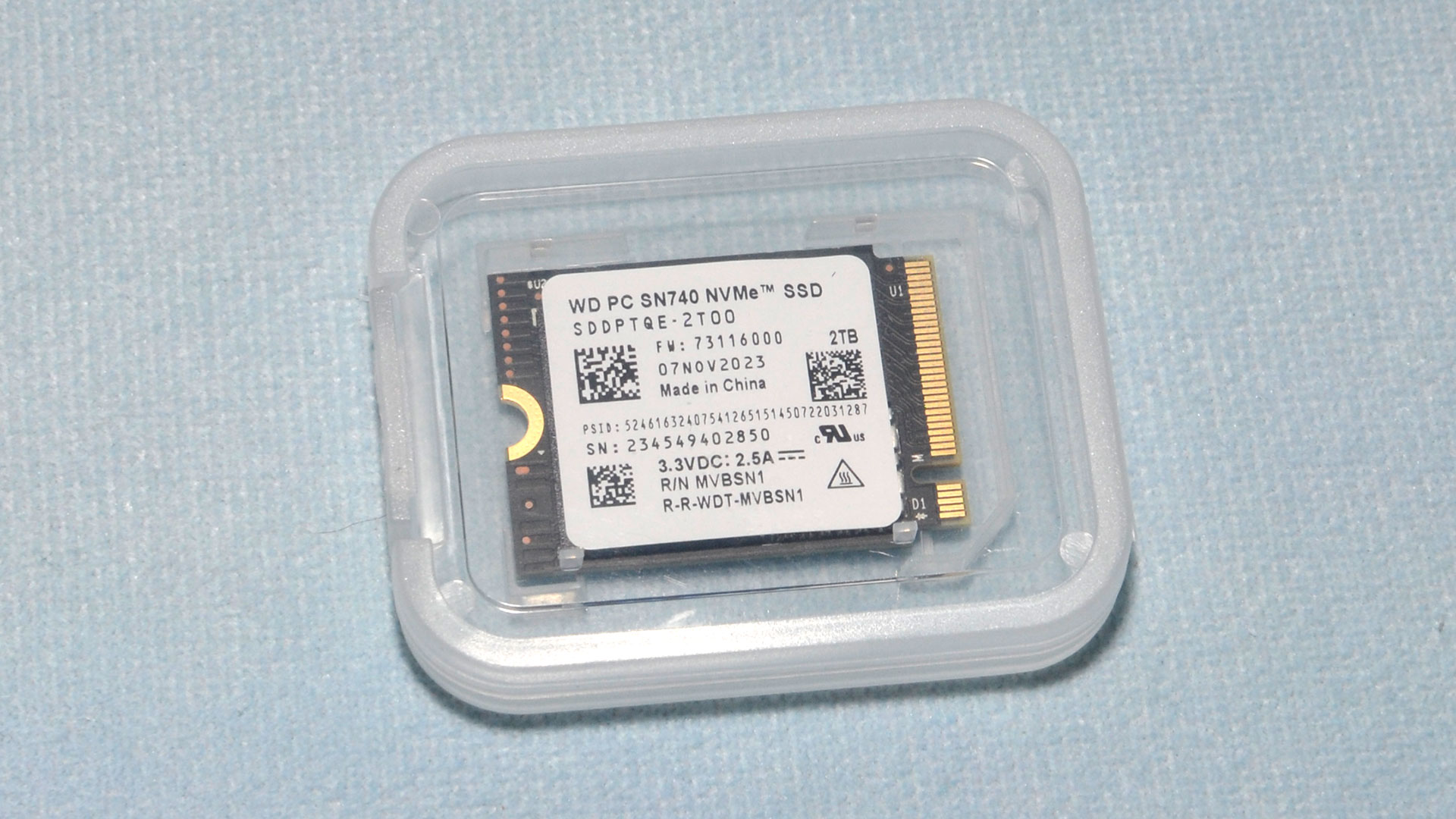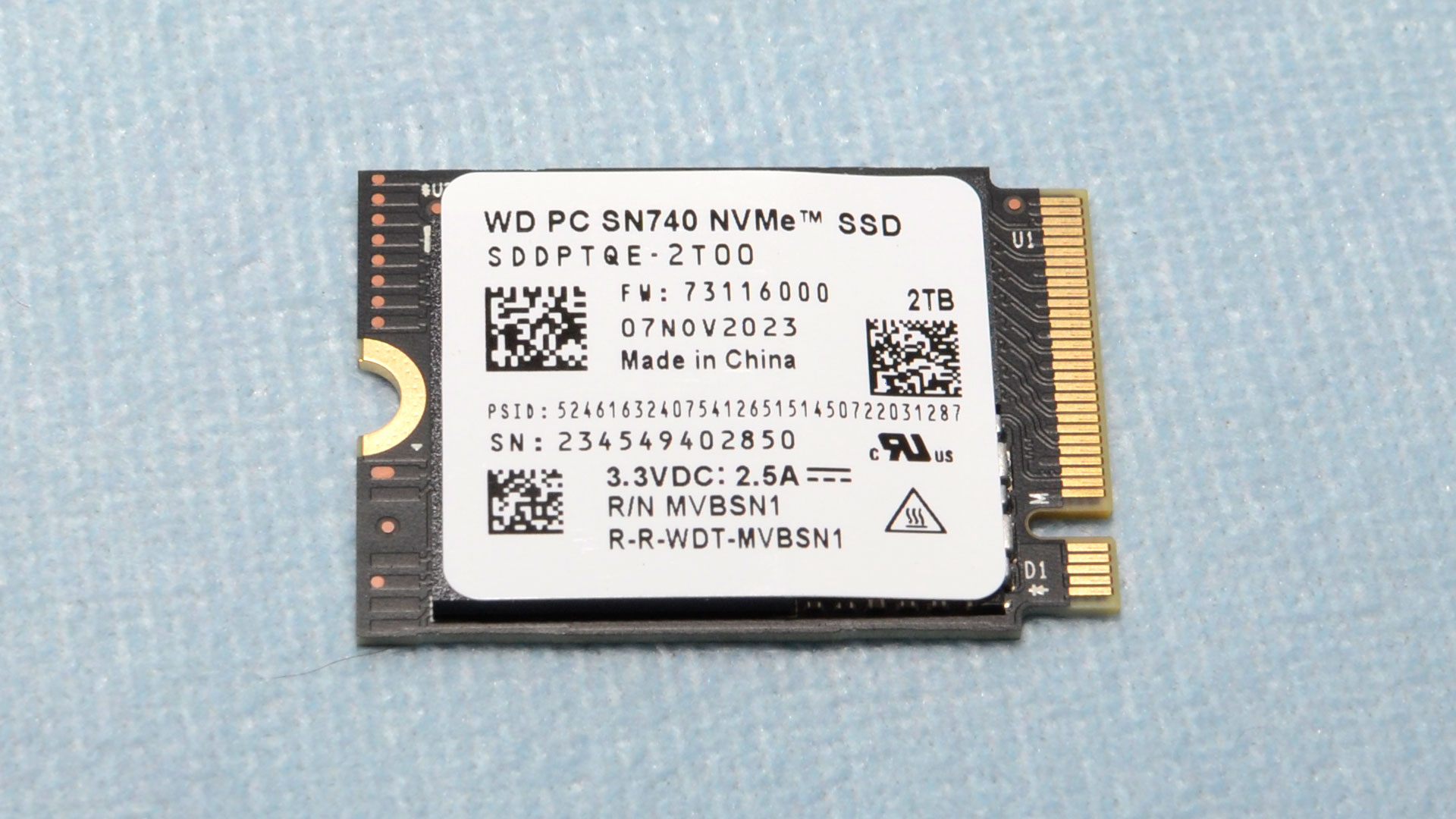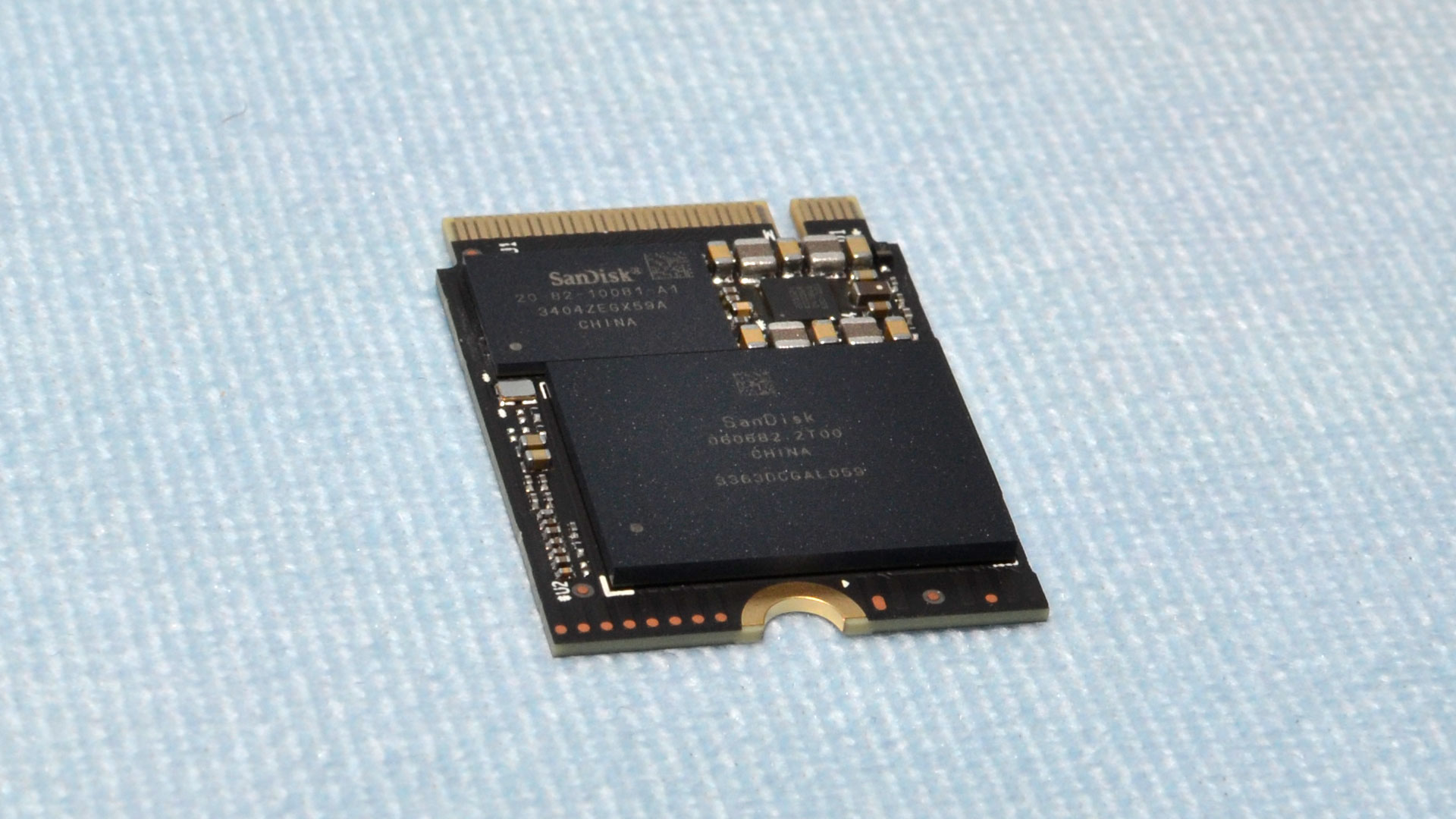Tom's Hardware Verdict
The WD SN740 is a popular OEM M.2 2230 SSD that brings TLC and decent performance to the popular portable device form factor. The trade-offs are more power and heat, which are generally worthwhile.
Pros
- +
Strong all-around performance
- +
TLC at 2TB for single-sided M.2 2230
Cons
- -
Runs a little hotter than desired
- -
Not particularly power-efficient
- -
OEM model
Why you can trust Tom's Hardware
The WD SN740 is one of the most popular M.2 2230 SSDs available for use in portable game systems like the Steam Deck, Steam Deck OLED, ASUS ROG Ally, Lenovo Legion Go, and more. Despite being an OEM drive, it achieved popularity because it offered the holy grail: 2TB of TLC NAND flash in a single-sided form factor. Most other TLC-based drives cap out at 1TB, while the use of QLC flash for 2TB requires compromises on performance. This made the SN740 and its rebrands top sellers, with the drive even being offered on Framework. WD would later capitalize on this popularity by releasing the retail WD Black SN770M.
The WD SN740 remains popular, being widely available even though it's designed for system OEMs. It can often be found at a lower price than the SN770M, and otherwise the two drives are similar. The hardware on the two drives is the same, but there are some differences such as with the inferior write endurance, or TBW, specifications.
The SN740 has the same faults as the SN770M, too: high power consumption and high temperatures under load. This can be a problematic combination for portable devices, though power-saving features mean the battery life at least wasn't compromised in our Steam Deck testing. One potential advantage of the SN740 is its optional support for hardware encryption, but that is a rather niche demand.
For PCIe 3.0 devices like the Steam Deck we think QLC flash is quite fine, unless you want the very best full-drive performance. For 4.0 devices, which is most other portable gaming systems, the SN740 remains viable, particularly if you want the best performance at 2TB. However, future M.2 2230 and 2242 drives look to supplant the SN740 and SN770M by offering equal or better performance at up to 2TB or more. These drives, like the existing TLC-based options that top out at 1TB, will be more efficient and cool-running than the SN740, which should be factored into any purchase decision.
WD SN740 specifications
| Product | 256GB | 512GB | 1TB | 2TB |
|---|---|---|---|---|
| Pricing | $17.99+ | $55.00+ | $79.95+ | $155.00+ |
| Form Factor | M.2 2230 (SS), M.2 2280 | M.2 2230 (SS), M.2 2280 | M.2 2230 (SS), M.2 2280 | M.2 2230 (SS), M.2 2280 |
| Interface / Protocol | PCIe 4.0 x4 / NVMe 1.4 | PCIe 4.0 x4 / NVMe 1.4 | PCIe 4.0 x4 / NVMe 1.4 | PCIe 4.0 x4 / NVMe 1.4 |
| Controller | SanDisk 20-82-10081-A1 | SanDisk 20-82-10081-A1 | SanDisk 20-82-10081-A1 | SanDisk 20-82-10081-A1 |
| DRAM | N/A (HMB) | N/A (HMB) | N/A (HMB) | N/A (HMB) |
| Memory | WD/Kioxia 112-Layer TLC (BiCS5) | WD/Kioxia 112-Layer TLC (BiCS5) | WD/Kioxia 112-Layer TLC (BiCS5) | WD/Kioxia 112-Layer TLC (BiCS5) |
| Sequential Read | 4,000 MB/s | 5,000 MB/s | 5,150 MB/s | 5,150 MB/s |
| Sequential Write | 2,000 MB/s | 4,000 MB/s | 4,900 MB/s | 4,850 MB/s |
| Random Read | 270K | 460K | 740K | 650K |
| Random Write | 470K | 800K | 800K | 800K |
| Security | TCG Pyrite 2.01/Opal 2.01 | TCG Pyrite 2.01/Opal 2.01 | TCG Pyrite 2.01/Opal 2.01 | TCG Pyrite 2.01/Opal 2.01 |
| Endurance (TBW) | 200TB | 300TB | 400TB | 500TB |
| Part Number | SDDPNQD/PTQD/QNQD/QTQD-256G | SDDPNQD/PTQD/QNQD/QTQD-512G | SDDPNQD/PTQD/QNQD/QTQD-1T00 | SDDPNQD/PTQD/QNQD/QTQD-2T00 |
| Warranty | 5-Year | 5-Year | 5-Year | 5-Year |
The WD SN740 is an OEM drive with a decent capacity range, from 256GB to 2TB. This allows more flexibility than the retail Black SN770M, which starts at 500GB, though most gaming portables would be better off with a higher capacity. There's also a small difference in marketed capacity, for example between 500GB on the SN770M and 512GB on the SN740. This is due to the SN740 having less overprovisioning, which does mean that it will have more user space available. This should not significantly impact performance or endurance.
The SN740 is an OEM drive so pricing will vary, but you can find a rebranded SN740 2TB on Amazon for $159. We purchased our test drive from AliExpress for $122, if you're willing to go that route. Either way, it's typically less expensive than the WD Black SN770M 2TB at $209 — with the drawbacks of not being a retail part and the lack of a manufacturer warranty.
The SN740 mostly performs the same as the SN770M, or the desktop M.2 2280 WD SN770 for that matter. Sequential performance tops out at 5,150/4,900 MB/s for reads / writes and the drive can hit up to 740K / 800K random read / write IOPS. Things deviate with the expected lifespan, as the SN740 has lower TBW at all capacities than its retail counterpart. This includes only 500TB written at 2TB, compared with 1200TB on the SN770M. Luckily, write endurance under warranty isn’t particularly important for this type of drive.
Another place the SN740 deviates is with it having SKUs that support hardware encryption through Opal 2.01. This is optional as the base SKUs are only TCG Pyrite 2.01 compatible, so be sure to look carefully at the model number if you are seeking hardware encryption support.
WD SN740 software and accessories
The WD SN740 is an OEM drive, so normally you would not expect much if any software support. WD’s Digital Dashboard lists specific support for Black, or WD_BLACK, SSDs like the Black SN770 and SN770M. The SN740 has the same hardware, though, and the Digital Dashboard does work with other SSDs.
WD also offers an OEM version of Acronis True Image but this also specifies Black SSDs. Luckily, there are free applications available for imaging and cloning if that doesn’t work for you. If you want to be completely sure about your drive being supported, buy a retail SN770M or a vendor-supported SN740.
WD SN740 — A closer look



Our SN740 sample is “SDDP” which indicates it does not support TCG Opal. This can be verified on WD’s site. This drive comes in both M.2 2230 and 2280 forms as well, so if you’re looking for encryption in the latter form factor you can get that with the SN740. In all cases, the drive is single-sided.
The label indicates the drive could pull up to 8W or more, but WD rates it for 6.3W peak and the highest power state by SMART is 5.4W. We’ll check in on the power consumption later in our testing.
The SN740 has an SSD controller and a single NAND flash package, without any DRAM present. It’s not common to find DRAM on M.2 2230 drives unless it’s part of an embedded package. That makes hitting 2TB more difficult, particularly with TLC flash, but DRAM is not explicitly required for SSDs. When physical space and simplicity are at a premium, this can be a worthwhile trade-off.
The 2TB SN740’s flash package has sixteen 1Tb BiCS5 dies. These are special BiCS5 dies with an interface speed of 1600 MT/s, allowing the SN740 to hit up to 5 GB/s or more with just a four-channel controller. This isn’t as exciting as it used to be, as there are now faster drives in this segment, but it’s more than enough to saturate a PCIe 3.0 device like the Steam Deck.
This hardware is the same as found on the popular SN770 and SN770M, and while powerful it's also starting to show its age. In particular, the SN740 is not as cool-running or as power-efficient as drives using newer hardware. This is more of a concern when packed into a small form factor designed for a portable device.
MORE: Best SSDs
MORE: Best Hard Drive
Get Tom's Hardware's best news and in-depth reviews, straight to your inbox.
MORE: Best SSD for the Steam Deck

Shane Downing is a Freelance Reviewer for Tom’s Hardware US, covering consumer storage hardware.
-
HideOut Shouldnt the endurance go up in a ratio the same as the storage pool size? 2TB should be double of 1, 1 should be double of 512 and such. This makes no sense. Misprint?Reply -
JarredWaltonGPU Reply
You might just try googling before questioning if it's a misprint. A few seconds brought me to the specs pages:HideOut said:Shouldnt the endurance go up in a ratio the same as the storage pool size? 2TB should be double of 1, 1 should be double of 512 and such. This makes no sense. Misprint?
https://www.westerndigital.com/products/internal-drives/pc-sn740-ssd?sku=SDDPNQE-2T00
And sure enough, WD has some curious numbers. 200TBW for 256GB, up to 500TBW for 2TB. Why? Because this is an OEM drive, and so the requirements are different. Apparently, WD doesn't want to give a "reasonable" TBW guarantee on larger models of the SN740. If you took the 200TBW for the 256GB and scaled it, that would be 1600TBW for the 2TB model, which would be more than what you get on the SN770M. 🤷
Realistically, I doubt there's a "drop dead" setting in the firmware, so the drives will work as long as they can, and that likely means the 2TB SN740 can do far more than the listed 500TBW. But it's not guaranteed. -
Avro Arrow The power difference between the WD SN740 (2.5W/GB) and the Corsair MP600 (1.7W/GB) is pretty substantial. We're talking a difference of 800W/TB and that can add up pretty quick.Reply
Having said that, they're SSDs and as such are already remarkably efficient compared to the old platter and optical drives. -
Aragorn Thats actually a total power of 2500Ws/TB (that's 2500WattSeconds or .694Wh to write a TB extrapolation from that graph, a non-negligible but still small amount of power. (Edited for bad math, missing a 10^3)Reply -
Notton I figured the TBW endurance was low, because it was a 2230 drive.Reply
Sabrent rocket Q4 2230 2TB also only has 450TBW.
When looking at the WD SN770 2TB, it has a similar chip configuration. 1x controller and 1x 2TB density NAND. However, it gets an endurance of 1200TBW.
I wonder if the rating for 2230 versions are so low due to heat? -
JarredWaltonGPU Reply
WD SN770M is virtually the same but has “normal” endurance rating and scaling.Notton said:I figured the TBW endurance was low, because it was a 2230 drive.
Sabrent rocket Q4 2230 2TB also only has 450TBW.
When looking at the WD SN770 2TB, it has a similar chip configuration. 1x controller and 1x 2TB density NAND. However, it gets an endurance of 1200TBW.
I wonder if the rating for 2230 versions are so low due to heat? -
cyrusfox Superb review! Great to see Tom's add this to your 2230 lineup.Reply
My main critique is this review is lacking a stronger discussion around pricing. GB/$ is king for most when looking at purchasing a drive, and this beats every other drive by min of $30 to 2x the price while offering comparable performance. The main drawback is OEM so good luck with a warranty if you need it... But many of us are comfortable with this, evident by us purchasing a drive off Aliexpress, won't lie as I was very worried about it being some fake drive for the price initially. Other point of contention, the 1TB are great for benchmark comparison, but they truly are a separate class, so the suggestion of purchasing BC711 doesn't make sense to me as it has no 2tb entry, would be a fairer fight to compare the sn740 1tb entry as I suspect its performance and efficiency profile may improve(Sacrifices were made to cram 2tb in this form factor). When we are in the 2tb class we are here because we need/desire the space.
It was great to see this drive sometimes beat the SN770M(at a fraction of the price) as well as having equivalent real world performance and battery life (which one would not expect from its poor efficiency showing). Also thank you for the in-depth sustained write performance data, really found the inconsistent performance intriguing as it seems to be capable of flushing the cache, speed returns only to fill it back up again and throttle down. The initial performance of the S91 is amazing on QLC, can't wait to see what WD can do with an update, but this might be the end of TLC, I would expect them to follow QLC for the next release...
I can't seem to find it anywhere but I would be interested in seeing what max temp was seen during the sustained write performance for each drive, gives a good indication on how the controller is tuned for performance and how important cooling is to maintain peak capabilities.
Thanks again to adding this to your line up of 2230 drives! Will be a great baseline going forward to compare against as we get newer entries into this small form factor space(I sure hope we see 4TB drives or pcie gen 5 entries even though both in this form factor is a bit absurd:cheese:). What we really need is someone brave enough to integrate a solid state fan (airjet) with these solid state drives (Throw power consumption out the window, make it PCIE gen 5 and set some records). I don't expect it to sell well, Optane didn't, as storage is too price sensitive of a space but like drag racing, it is a fun hobby. -
JarredWaltonGPU Reply
The reviews should all have temperature data, though only when running in the desktop system. The SN740 reports three different temperatures in HWiNFO64, and they're all quite high. The first and third numbers appear to be the same and peaked at 91C in our write saturation test, while the second number peaked at 101C. Yeah, that's hot. The good news is that in PCIe 3.0 mode the temps were MUCH lower: 62C on the first and third columns, and 74C on the second column.cyrusfox said:Superb review! Great to see Tom's add this to your 2230 lineup.
I can't seem to find it anywhere but I would be interested in seeing what max temp was seen during the sustained write performance for each drive, gives a good indication on how the controller is tuned for performance and how important cooling is to maintain peak capabilities.
The WD SN770M seems to have been tuned to be a bit better on thermals, with the first and third columns at 85C peak and 95C for the second column when operating in PCIe 4.0 mode. Again, PCIe 3.0 greatly reduces thermals and it peaked at 70C / 80C — so hotter in PCIe 3.0 mode than the SN740, but cooler in PCIe 4.0 mode. 🤷
The QLC NAND and Phison E21T combination incidentally tends to hit max temps of around 65~70C in the same write saturation testing. Obviously, being able to write at much higher sustained speeds with TLC is a big part of that.
